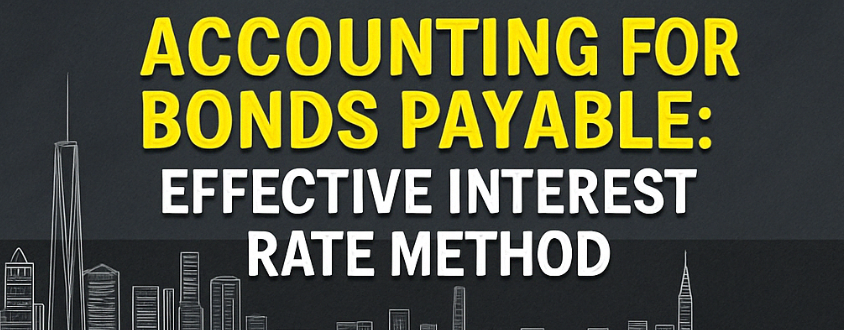Accounting for Bonds Payable: Effective Interest Rate Method
- Graziano Stefanelli
- 2 days ago
- 3 min read

When a company issues bonds, the accounting doesn't stop at the date of issuance.
Over the life of the bond, interest expense must be recognized — and when bonds are issued at a discount or premium, the Effective Interest Rate Method provides a consistent and theoretically sound approach to spreading that interest expense.
This article walks through how the method works, why it’s preferred over the straight-line approach, and how to apply it with real numbers.
What Is the Effective Interest Rate Method?
The Effective Interest Rate Method (EIRM) is used to amortize the difference between a bond's face value and its issue price over the bond’s life.
It’s based on applying a constant interest rate — the market rate at the time of issuance — to the carrying amount of the bond at the beginning of each period.
This method produces a more accurate allocation of interest expense and reflects the time value of money more faithfully than the straight-line method.
Core Concepts and Terms
Face Value (Par): The amount the issuer repays at maturity.
Issue Price: The amount investors pay at issuance (can be above or below face value).
Coupon Rate: The stated annual interest rate on the bond.
Effective Rate: The market interest rate at the time the bond is issued.
Carrying Amount: The net book value of the bond, updated each period as premiums or discounts are amortized.
Why the Effective Interest Method Is Used
The key advantage of EIRM is that it aligns the reported interest expense with the economic cost of borrowing.
Rather than recognizing a fixed interest amount each period (as with straight-line), it calculates interest as:
Interest Expense = Carrying Amount × Effective Rate
This results in:
Higher interest expense early on discounted bonds
Lower interest expense early on premium bonds
It reflects the real financial cost of borrowing more accurately.
How the Method Works
Step-by-Step Process
Determine the bond’s issue price (using PV of future cash flows)
Calculate the initial carrying amount
Each period:
Compute interest expense: Carrying Amount × Effective Rate
Compute cash interest paid: Face Value × Coupon Rate
Find the difference (premium or discount amortization)
Adjust the carrying amount accordingly
Example: Bond Issued at a Discount
A company issues a 5-year bond with:
Face value: 100,000
Coupon rate: 6% annually
Market rate (effective): 8%
Interest paid annually
The bond is sold at a discount, so the issue price (PV of future cash flows) is 92,278.
Year 1 Calculation
Beginning carrying amount: 92,278
Interest expense: 92,278 × 8% = 7,382.24
Cash paid: 100,000 × 6% = 6,000
Amortization: 7,382.24 – 6,000 = 1,382.24
New carrying amount: 92,278 + 1,382.24 = 93,660.24
Year 2 Calculation
Beginning carrying amount: 93,660.24
Interest expense: 93,660.24 × 8% = 7,492.82
Cash paid: 6,000
Amortization: 1,492.82
New carrying amount: 93,660.24 + 1,492.82 = 95,153.06
Repeat this process each year until the bond matures and the carrying amount reaches the face value.
Example: Bond Issued at a Premium
Now assume the company issues the same bond but the market rate is 4%.
The issue price would be 108,530.
Year 1 Calculation
Beginning carrying amount: 108,530
Interest expense: 108,530 × 4% = 4,341.20
Cash paid: 6,000
Amortization: 6,000 – 4,341.20 = 1,658.80 (premium amortized)
New carrying amount: 108,530 – 1,658.80 = 106,871.20
As the premium amortizes, the carrying amount approaches face value.
Journal Entries
For Bonds at a Discount (Year 1)
At issuance:
Dr Cash 92,278
Dr Discount on Bonds Payable 7,722
Cr Bonds Payable 100,000
Year 1 interest:
Dr Interest Expense 7,382.24
Cr Discount on Bonds Payable 1,382.24
Cr Cash 6,000
For Bonds at a Premium (Year 1)
At issuance:
Dr Cash 108,530
Cr Premium on Bonds Payable 8,530
Cr Bonds Payable 100,000
Year 1 interest:
Dr Interest Expense 4,341.20
Dr Premium on Bonds Payable 1,658.80
Cr Cash 6,000
Comparison to Straight-Line Method
Feature | Effective Interest | Straight-Line |
Accuracy | Higher | Lower |
GAAP/IFRS compliance | Required if material | Allowed only if immaterial |
Expense pattern | Varies with carrying amount | Fixed each period |
Amortization | Increases over time (discount) | Constant |
When to Use This Method
The Effective Interest Method is required under:
IFRS: Always required
U.S. GAAP: Required if the difference between the methods is material
It’s the preferred method for high-value bonds, long-term debt, or when accurate interest representation is necessary.
__________________________
The Effective Interest Rate Method offers a systematic way to reflect the true cost of borrowing over time.
By applying the market rate to the carrying amount, it aligns the interest expense with the economic reality of the bond agreement.
This approach:
Accurately amortizes bond discounts and premiums
Complies with accounting standards
Supports transparent and logical financial reporting


Opmerkingen